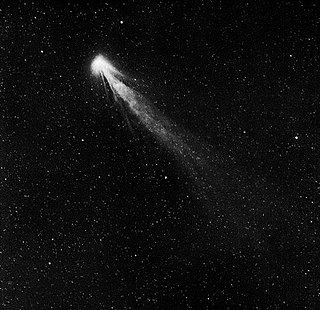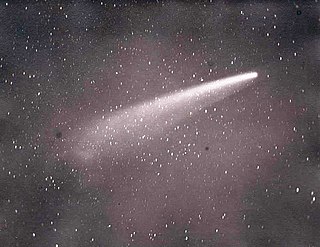
Comet Giacobini–Zinner is a periodic comet in the Solar System. It was discovered by Michel Giacobini, who observed it in the constellation of Aquarius on 20 December 1900. It was recovered two orbits later by Ernst Zinner, while he was observing variable stars near Beta Scuti on 23 October 1913.

Comet Humason, formally designated C/1961 R1, was a non-periodic comet discovered by Milton L. Humason on 1 September 1961. Its perihelion was well beyond the orbit of Mars, at 2.133 AU. The outbound orbital period is about 2,516 years.

The Great Comet of 1882, formally designated as C/1882 R1, 1882 II, and 1882b, was a comet which became very bright in September 1882. It was a member of the Kreutz Sungrazers, a family of comets which pass within 1 R☉ of the Sun's photosphere at perihelion.

101P/Chernykh is a periodic comet which was first discovered on August 19, 1977, by Nikolaj Stepanovich Chernykh. It will next come to perihelion in 2034.

Comet Finlay is a periodic comet with an orbital period of 6 years discovered by William Henry Finlay on September 26, 1886. The next perihelion passage is July 13, 2021 when the comet will have a solar elongation of 54 degrees at approximately apparent magnitude 10. It last came to perihelion on December 27, 2014, at around magnitude 10. Of the numbered periodic comets, the orbit of 15P/Finlay has one of the smallest minimum orbit intersection distances with the orbit of Earth (E-MOID). In October 2060 the comet will pass about 5 million km from Earth.

C/2001 Q4 (NEAT) is a comet with an almost perpendicular retrograde orbit which brings it into the inner Solar System by a deeply southward path. It initially emerged from its remote home spending most of its time near the south celestial pole. This comet was discovered on August 24, 2001 by the Near-Earth Asteroid Tracking program (NEAT).
Comet C/1861 G1 (Thatcher) is a long-period comet with roughly a 422-year orbit that is expected to return around 2283. It was discovered by A. E. Thatcher. It is responsible for the April Lyrid meteor shower. Carl Wilhelm Baeker also independently found this comet. The comet passed about 0.335 AU from the Earth on 5 May 1861 and last came to perihelion on 3 June 1861.
C/2007 W1 (Boattini) is a non-periodic comet discovered on 20 November 2007, by Andrea Boattini at the Mt. Lemmon Survey. At the peak the comet had an apparent magnitude around 5.

C/1992 J1 (Spacewatch) is a comet that was discovered 1 May 1992 by David Rabinowitz of the Spacewatch Project. This was the first comet to be discovered using an automated system.
82P/Gehrels is a periodic comet that was discovered on October 27, 1975, by Tom Gehrels at the Palomar Mountain Observatory in California having a faint nuclear brightness of magnitude 17.
C/2001 OG108 (LONEOS) is a Halley-type comet with an orbital period of 48.51 years. It was discovered on 28 July 2001 by the LONEOS telescope at Lowell Observatory. Of the short-period comets with known diameters and perihelion inside the orbit of Earth, C/2001 OG108 is the second largest after Comet Swift–Tuttle.

C/1999 S4 (LINEAR) was a hyperbolic comet discovered by the Lincoln Near-Earth Asteroid Research survey on 27 September 1999.
51P/Harrington is a periodic comet in the Solar System.
Comet Stonehouse, formally designated C/1998 H1, is a non-periodic comet discovered in April 22, 1998 by Patrick L. Stonehouse of Wolverine, Michigan, USA.
In observational astronomy, the observation arc of a Solar System body is the time period between its earliest and latest observations, used for tracing the body's path. It is usually given in days or years. The term is mostly used in the discovery and tracking of asteroids and comets. Arc length has the greatest influence on the accuracy of an orbit. The number, spacing of intermediate observations, and timestamps have a lesser effect.
C/2015 G2 (MASTER) is a comet discovered April 7, 2015 by MASTER, the Mobile Astronomical System of the Telescope-Robots at the South African Astronomical Observatory (SAAO). It was the first comet discovered from South Africa in 35 years.

C/2015 ER61 (PanSTARRS) is a comet and inner Oort cloud object. When classified as a minor planet, it had the fourth-largest aphelion of any known minor planet in the Solar System, after 2005 VX3, 2012 DR30, and 2013 BL76. It additionally had the most eccentric orbit of any known minor planet, with its distance from the Sun varying by about 99.9% during the course of its orbit, followed by 2005 VX3 with an eccentricity of 0.9973. On 30 January 2016, it was classified as a comet when it was 5.7 AU from the Sun. It comes close to Jupiter, and a close approach in the past threw it on the distant orbit it is on now.

C/2019 U6 (Lemmon), or Comet Lemmon is a long period comet with a near-parabolic orbit discovered by the Mount Lemmon Survey on October 31, 2019. It made its closest approach to the Sun on June 18, 2020. In June 2020 it was visible near the naked eye limit at an apparent magnitude of 6.0. It is the 3rd brightest naked eye comet of 2020 after C/2020 F3 (NEOWISE) and C/2020 F8 (SWAN). It remained visible near the naked eye limit in June.

C/2019 Y1 (ATLAS) is a comet with a near-parabolic orbit discovered by the ATLAS survey on 16 December 2019. It passed perihelion on 15 March 2020 at 0.84 AU from the Sun. Its orbit is very similar to C/1988 A1 (Liller), C/1996 Q1 (Tabur), C/2015 F3 (SWAN) and C/2023 V5 (Leonard), suggesting they may be fragments of a larger ancient comet.
C/2021 O3 (PanSTARRS) is perhaps an Oort cloud comet, discovered on 26 July 2021 by the Pan-STARRS sky survey. It came to perihelion on 21 April 2022 at 0.287 AU (42.9 million km). from the Sun.













